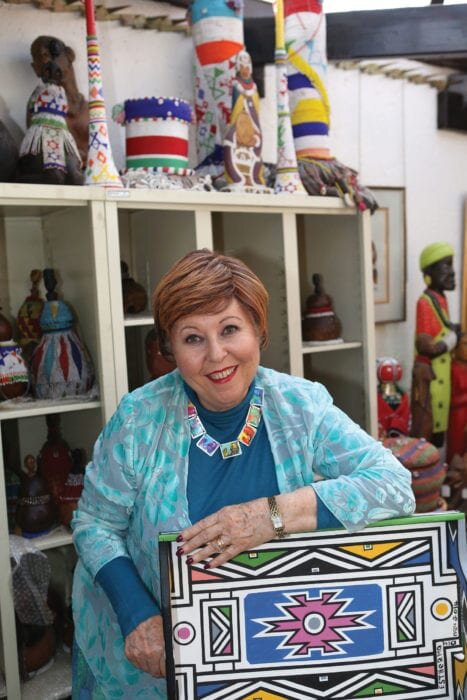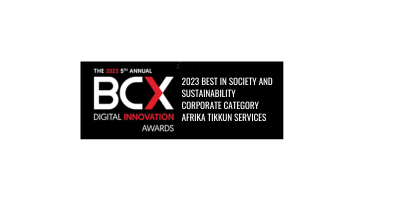Women in Business Series: Natalie Knight
collector and documenter of Ndebele and Shangaan art, admitted attorney, curator of We Love Mandela exhibition at South Africa House, London in 2013
Are you satisfied with South Africa’s efforts in regards to empowering and promoting female artists?
I think that there has been a vast improvement in this regard in the commercial art world. Obviously, there is a long way to go but many women artists have received recognition and acclaim, including Esther Mahlangu, Noria Mabasa, Helen Sibidi, Marlene Dumas, Penny Siopis, Jane Alexander and others. Many women have had to make their mark first as art teachers and lecturers but women have to struggle harder to become recognised, possibly because of the demands of family life.
According to The Observer, the US art world is a US$760b industry, yet female artists access a relatively small portion of this wealth. Do we have the same problem in South Africa?
I don’t know the statistics in South Africa but I don’t think we have barriers against women entering the industry. There are many women in top positions in the art world. Financial control seems to still be in the hands of the males, although women are making in-roads. E.g. the Latitudes Art Fair is being run by four women.
How are women faring in regards exercising creative and financial control of the arts and what can be done to improve the situation?
I had no problem at all being a woman setting out to establish an art gallery in 1981. It is hard to generalise but I think that women are gaining more opportunities for creative control. Unfortunately l have personally been very disappointed and let down by a few women whom I tried to help when they entered the art world as curators and gallerists. There are seminars available to teach business ethics etc. The situation can be improved with information and experience.
As an expert on African art and culture, how central is the woman to African art and culture? Do you think this has been explored sufficiently?
The African woman is central to African art and culture. In addition to mural paintings, the rural African woman has skills such as beadwork and embroidery which were denigrated as “craft.” I think that I have been instrumental in raising the perception of these skills which are now seen as art after I promoted them in several Museum shows, books and interactive slide presentations both locally and internationally. My research into the Ndebele and Tsonga/Shangaan art and culture records the dominance of women as the creative spark although the males dominate in wood carving.
What has been one of your proudest moments in your long career?
There are many but one stands out head and shoulders above the rest – meeting Nelson Mandela in the Natalie Knight Art Gallery, Hyde Park and curating art shows in his honour.
What would you say has been your biggest challenge in life and how did you overcome it?
Being the only woman in my law class and being ignored by the lecturers who addressed the class as ‘Good morning Gentlemen.’ I overcame this by working hard and obtaining distinctions which put me among the top scholars and eligible for the Law Prize. I didn’t get the prize because I got married in my final year and the Law Prize was no longer an important goal for me. My mother was unique in her day for qualifying as an attorney and she had many challenges such as the banks refusal to allow her to open her own bank account. She gave me a good sense of self-esteem.


Did being a woman help or hinder you in your career?
Apart from the above experience I didn’t find that being a woman hindered me. I attribute my success largely to my husband, a lawyer, who supported me in all my endeavours. I felt that as a woman I had special talents of empathy and intuition and was a bit naïve and trusting .When male clients tried to bully me, I had to learn to toughen up. I was known as being tough but fair in business and because of my legal training, I was able to stand up for my rights. I believe that women should foster their own talents and strengths and not try to become like males. I am not a militant feminist but I was quoted as saying, “Any woman who wants equality with a man is an under-achiever.”
The phrase “starving artist” is still very prevalent today. What advice can you give young women who are considering becoming artists, to become financially self-sustaining?
Being an artist – male or female – is a risky career choice. Usually, it’s necessary to have a ‘day job’ as well, either as a teacher or a graphic designer. Try to do something connected with the art world.
Are you involved in any initiatives where you assist less fortunate women to improve their circumstances?
In the 70’s I helped Ndebele women to sell their beaded items. I met and photographed Esther Mahlangu in 1983 when she was unknown and selling commercial items of beadwork. I later
exhibited her work in New York in 1997 on a show called Ndebele-Then and Now.
While I had my gallery and consultancy I worked with Jane Makhubele and her family for over 30 years buying and marketing her beautiful beaded Tsonga/Shangaan ncekas. This included featuring Makhubele’s work on the exhibition called Dungamanzi – Tsonga and Shangaan art from southern Africa held at the Johannesburg Art Gallery in 2007.
During Covid-19 I organised a 3 session Zoom Webinar with Afrika-Tikkun in which I distributed copies of Dungamanzi to the graduate students on the topic of Art, Culture and Language. We distributed art posters as prizes to the students who responded well to the discussions with me and Asher Marcus, a young architect with whom I have formed a new business. Now that I am in my eighties, I am less able to undertake new initiatives.



